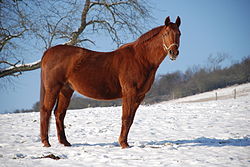Rhenish warmblood
| Rhenish warmblood | |
|---|---|

Rhinelander chestnut mare in the snow |
|
| Important data | |
| Origin: | North Rhine-Westphalia |
| Main breeding area: | Rhineland |
| Distribution: | Germany |
| Stick measure : | 160-170 cm |
| Colors : | all basic colors |
| Main application area: | Riding horse |
The Rhenish Warmblood is a relatively young German horse breed .
Background information on horse evaluation and breeding can be found under: Exterior , interior and horse breeding .
Exterior
The Rhenish Warmblood, also called Rhinelander, is a warm-blooded animal of the German riding horse type . Characteristics are a light neck, a long instep , stable back, deep, medium-wide torso as well as a strong, slightly sloping high-performance croup and a deep tail . They also have hard extremities and no hangings. They are available in all basic colors and their height is around 160 to 170 cm.
interior
The Rhenish Warmblood is a horse of the medieval type with good mechanics and sweeping, expansive basic gaits. It also has a good jumping ability and is therefore suitable as a sport horse for all disciplines.
history
The Rheinland has long been the main breeding area of the Rheinisch-German cold blood . Only after the Second World War , following the example of other federal states, was their own warmblood breed established. The breeding is based primarily on mares from Westphalia as well as horses from the Hanoverian breed and Trakehner . The breeding was standardized through the heavy use of East Prussian stallions. Later on, stallions of Hanoverian-Westphalian descent were preferred. Today Holstein and thoroughbreds are also used.
Breeding organization
The Rhenish Horse Breeding Association is based in Wickrath Castle in Mönchengladbach-Wickrath . This is where the studbook is kept. In practice, the breeders are looked after by the local district horse breeding associations, which work in cooperation with the horse studbook and organize the registration of mares and foals.